Would you like to test Sellead Performance Report?
The problem is that for Education Agencies companies, opportunities are made of multiple leads and each lead may have a different Lead Source. When the opportunity is assigned a Lead Source, a salesperson or CRM assigns it based on any number of criteria — criteria which may not reflect the most important or influential lead channel.
This problem is compounded by inconsistent methods used to measure Lead Source.
In this post we’ll explain why Lead Source and First Touch data is so important. And how to measure it correctly.
Why Consistent Lead Source Data is Essential For Improving Demand Generation
Accurately attributing credit to channels and campaigns is the foundation for successful reporting. And a large part of reporting examines the performance of marketing channels. Whether they are the channels related to new campaigns or strategies, marketers must trust that Lead Source data is accurate so that budget changes result in predictable outcomes.
The Connection Between Lead Source And Opportunity First Touch
Measuring channel influence on Opportunities requires marketers to understand the Opportunity’s First Touch Channel, i.e. which is the Lead Source of the lead who later becomes an Opportunity.
The Opportunity First Touch Channel is the channel that drove and influenced the Opportunity. Without consistent measurement of Lead Source you cannot trust the accuracy of the Opportunity First Touch data.
To illustrate, look at the diagram below. It shows your contacts, or leads, in an opportunity. It shows their Lead Source as well. Notice how difficult it is to determine how the Opportunity discovered your brand if you do not know which channel should be counted as the Opportunity’s First Touch, i.e. the “opportunity source.”
All The Different Ways Lead Source Is Determined
Lead Source may be determined by the touchpoint of the lead closest to when the opportunity is created, i.e. the opportunity created touch. Or, it may be determined by the first touch of the first lead associated with the opportunity or by what the sales team enters into the CRM.
Different ways of measuring Lead Source can be a problem.
Using different methods to determine an Opportunity’s Lead Source means inconsistency in the data.
You can’t compare two opportunities with the same Lead Source if the criteria for determining it were different.
For example, let’s say that your CRM report says Opportunity 1 and Opportunity 2 both came from Organic. However, you might not know that Opportunity 1 uses contacts’ first touch to determine Opportunity First Touch and Opportunity 2 uses contacts’ opportunity create touch to determine Opportunity First Touch.
Imagine You’re In Charge Of Marketing Reporting
When it comes to making budget allocation decisions and planning how you want to spend the marketing budget for the next quarter, realizing your Lead Source data is inconsistent does not give you confidence.
Second, choosing the wrong method for measuring Lead Source means your marketing data does not come close to representing how leads found you and what kinds of interactions were most influential in getting the leads to convert. In other words, you are unsure whether an opportunity’s first touch is truly their first engagement with your brand.
Data is a representation of prospect activities and a representation of what causes groups of prospects to convert. When measuring for marketing reporting, the first order of business is always making sure your data is consistent. Lead Source measurement is the perfect example.
How To Gain Consistent and Accurate Lead Source Data
There are two requirements for accurate and consistent FIrst Touch data.
#1:Tracking must be comprehensive. Every contact in an opportunity, no matter online or offline, must have a custom Lead Source field attached to it.
Comprehensiveness sets the foundation so that when you decide which method you use to determine the first touch for an opportunity.
When looking at opportunities, every lead (contact) must be tagged with a dynamic field. Why? When you identify the Lead Source for the Opportunity, you use the data from the entire group of leads in the opportunity, not from one lead or from some leads.
#2:Tracking must be dynamic. This means changes or updates must take place automatically and in real time. With many opportunities it’s essential that tracking is setup correct from the beginning.
The graphic below illustrates this point. Notice how the First Touch (or Lead Source) of the Opportunity changes as a fourth prospects enters into the deal and their first touch data reveals paid social as the channel that drove the opportunity.
Click images to enlarge.
Dynamic tracking keeps the touchpoint information up to date. This is important because there are many touchpoints that happen as a leads and opportunities progress through the sales process.
When there are multiple prospects who have visit your site, the anonymous first touch information that you collect is stored until they convert on the lead create touch. Dynamic tracking will automatically keep this information updated for groups of leads.
In order to get accurate data via dynamic and comprehensive tracking, marketers use Sellead’s attribution solution. Marketers often are surprised by the new insights on channel performance after implementing Sellead’s touchpoint tracking.
Whether overvaluing or undervaluing channels, this issue magnifies in importance when studying opportunities. Knowing where your best opportunities come from is much more important than knowing where your leads come from. Opportunity data tells businesses where customers and revenue come from. It’s a data set that must be managed with consistency and accuracy.




